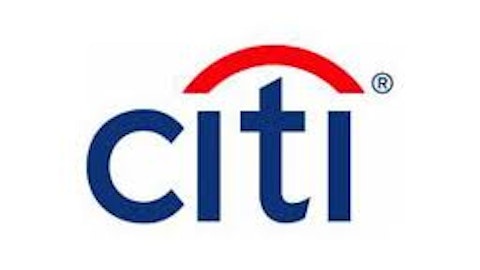Among all of the hoopla in the last few years about big banks, something that seems to be getting lost in the shuffle is, a few “big banks” are actually doing pretty well. In fact, I would argue that many of the big banks represent good values at the current time. Though JPMorgan Chase & Co. (NYSE:JPM) has been put through the wringer over its trading practices, there are at least five solid reasons to consider buying the stock.
Stronger, higher, better

In the big bank sector, it’s pretty easy to identify the biggest names. Along with companies like JPMorgan, I would include Bank of America Corp (NYSE:BAC), Wells Fargo & Co (NYSE:WFC), and Citigroup Inc (NYSE:C). If I had a nickel for every time one of these banks was brought up in the “too big to fail” conversation, I could probably buy one of these institutions outright.
When I compare these companies recent earnings, the adjectives to describe JPMorgan Chase & Co. (NYSE:JPM) are words like stronger, higher, and better. Investing isn’t always that difficult: find the strongest institution among a group and buy that stock.
Strongest in deposit growth, loans represent an opportunity
The first reason to buy JPMorgan is they are showing stronger deposit growth than their peers. In fact, in the last three months, the company saw period end deposits increase by 7%. By comparison, Wells Fargo & Co (NYSE:WFC) came in a close second with a 6.36% growth rate, Bank of America Corp (NYSE:BAC) saw an increase of 4.38%, and Citigroup Inc (NYSE:C) grew deposits by 3%. For all the talk about customers leaving big banks, the money is flowing into JPMorgan.
A second reason to consider the stock is, the huge opportunity in front of the bank if they can turn around their real estate loans. On an overall basis, the company saw loans up 1%. This performance was better than Bank of America Corp (NYSE:BAC) with loans down 0.84%, but lagged Wells Fargo’s increase of 3.84%, and Citigroup’s increase of 5%.
However, JPMorgan’s total loans were dragged down by the company’s real estate dealings, where mortgage loans dropped 7.54%, and home equity loans decreased 12.31%. Considering that business loans were up 6%, commercial banking loans increased 14%, and asset management loans were up 35%, imagine the company’s overall performance if they could just show small growth in the real estate portfolio.
It’s all about quality
Say what you will about JPMorgan Chase & Co. (NYSE:JPM)’s decision making when it comes to complicated trades, but when it comes to handling non-performing loans, they are the best. The company’s non-performing loan percentage dropped to 1.6%. In addition, the total dollars of non-performing loans dropped by a class leading 20.55%. These numbers represent the third and fourth reasons to buy the stock.
JPMorgan’s peers just don’t come close to matching the bank’s low non-performing percentage and the percentage decline in this category. The bank that came closest in non-performing loan percentage was Citigroup Inc (NYSE:C) with a 1.72% ratio. However, Citigroup’s decline in non-performers was 12% compared to over 20% at JPMorgan. Wells Fargo & Co (NYSE:WFC) Bank of America Corp (NYSE:BAC) are in a different class, and not in a good way. These two banks have non-performing loan ratios of 2.53% at Bank of America, and 2.44% at Wells Fargo. Again, while Bank of America Corp (NYSE:BAC) saw a 17.8% decrease in problem loans, they can’t match JPMorgan, and they are starting from a much higher percentage. Wells Fargo & Co (NYSE:WFC) has the double whammy of a high percentage of problem loans, and their decrease in these assets was the lowest of the group at just 7.21%.
The bottom line in credit quality is, JPMorgan already has the lowest ratio, and these problem loans are declining faster than any of their peers.
$6 billion reasons
The final reason to consider JPMorgan stock is, the company plans on retiring $6 billion in shares over the next four quarters. At current prices, this buyback would retire about 3.3% of the outstanding share count. With analysts calling for 7% EPS growth, this share repurchase could lift that figure. Since the shares carry over a 3% yield, and sell for less than 9 times projected earnings, this looks like quite a deal for investors.
During all of the financial turmoil, JPMorgan and Wells Fargo earned their reputations as strong, well managed institutions. Now that the economy is beginning to mend, JPMorgan seems to be pulling ahead of the pack. Long-term investors should consider adding JPM to their portfolio today.
The article 5 Reasons To Buy This Bank originally appeared on Fool.com is written by Chad Henage.
Copyright © 1995 – 2013 The Motley Fool, LLC. All rights reserved. The Motley Fool has a disclosure policy.

